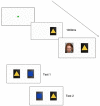Mapping the Specific Pathways to Early-Onset Mental Health Disorders: The "Watch Me Grow for REAL" Study Protocol
- PMID: 32636770
- PMCID: PMC7319093
- DOI: 10.3389/fpsyt.2020.00553
Mapping the Specific Pathways to Early-Onset Mental Health Disorders: The "Watch Me Grow for REAL" Study Protocol
Abstract
Background: From birth, the human propensity to selectively attend and respond to critical super-stimuli forms the basis of future socio-emotional development and health. In particular, the first super-stimuli to preferentially engage and elicit responses in the healthy newborn are the physical touch, voice and face/eyes of caregivers. From this grows selective attention and responsiveness to emotional expression, scaffolding the development of empathy, social cognition, and other higher human capacities. In this paper, the protocol for a longitudinal, prospective birth-cohort study is presented. The major aim of this study is to map the emergence of individual differences and disturbances in the system of social-Responsiveness, Emotional Attention, and Learning (REAL) through the first 3 years of life to predict the specific emergence of the major childhood mental health problems, as well as social adjustment and impairment more generally. A further aim of this study is to examine how the REAL variables interact with the quality of environment/caregiver interactions.
Methods/design: A prospective, longitudinal birth-cohort study will be conducted. Data will be collected from four assessments and mothers' electronic medical records.
Discussion: This study will be the first to test a clear developmental map of both the unique and specific causes of childhood psychopathology and will identify more precise early intervention targets for children with complex comorbid conditions.
Keywords: attention; child; eye-tracking; infant; learning; mental health; protocol; responsiveness.
Copyright © 2020 Doyle, Mendoza Diaz, Eapen, Frick, Kimonis, Hawes, Moul, Richmond, Mehta, Sareen, Morgan and Dadds.
Figures





Similar articles
-
Motor trajectories from birth to 5 years of children born at less than 30 weeks' gestation: early predictors and functional implications. Protocol for a prospective cohort study.J Physiother. 2016 Oct;62(4):222-3. doi: 10.1016/j.jphys.2016.07.002. Epub 2016 Aug 5. J Physiother. 2016. PMID: 27634166
-
Mental health problems and psychopathology in infancy and early childhood. An epidemiological study.Dan Med Bull. 2010 Oct;57(10):B4193. Dan Med Bull. 2010. PMID: 21040689 Review.
-
Right care, first time: a highly personalised and measurement-based care model to manage youth mental health.Med J Aust. 2019 Nov;211 Suppl 9:S3-S46. doi: 10.5694/mja2.50383. Med J Aust. 2019. PMID: 31679171
-
Toward a transdiagnostic model of common and unique processes leading to the major disorders of childhood: The REAL model of attention, responsiveness and learning.Behav Res Ther. 2019 Aug;119:103410. doi: 10.1016/j.brat.2019.103410. Epub 2019 Jun 1. Behav Res Ther. 2019. PMID: 31176136
-
Assessment of young children's social-emotional development and psychopathology: recent advances and recommendations for practice.J Child Psychol Psychiatry. 2004 Jan;45(1):109-34. doi: 10.1046/j.0021-9630.2003.00316.x. J Child Psychol Psychiatry. 2004. PMID: 14959805 Review.
Cited by
-
Towards Preventative Psychiatry: Concurrent and Longitudinal Predictors of Postnatal Maternal-Infant Bonding.Child Psychiatry Hum Dev. 2023 Dec;54(6):1723-1736. doi: 10.1007/s10578-022-01365-0. Epub 2022 May 26. Child Psychiatry Hum Dev. 2023. PMID: 35616764 Free PMC article.
-
Study Protocol: Longitudinal Attention and Temperament Study.Front Psychiatry. 2021 Jun 8;12:656958. doi: 10.3389/fpsyt.2021.656958. eCollection 2021. Front Psychiatry. 2021. PMID: 34168577 Free PMC article.
References
-
- Department of Health and Ageing National Mental Health Report 2013: Tracking progress of mental health reform in Australia 1993 – 2011. Canberra, Australia: Commonwealth of Australia; (2013).
-
- Heckman JJ. Invest in the Very Young. Chicago, Illinois: Ounce of Prevention Fund and the University of Chicago Harris School of Public Policy Analysis; (2002).
LinkOut - more resources
Full Text Sources

